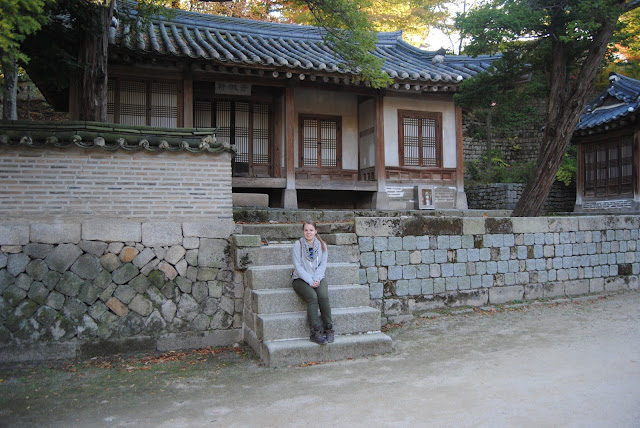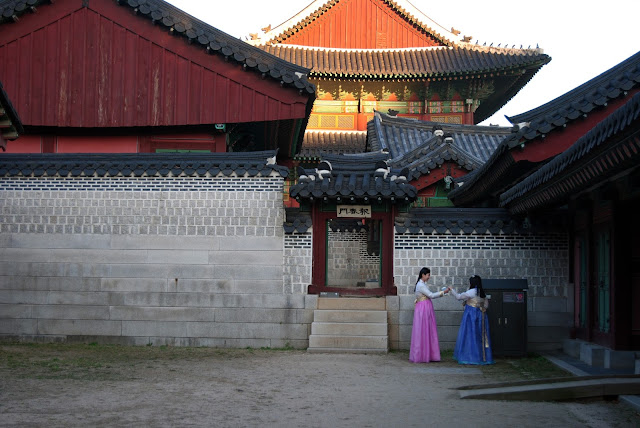Seoul - Changdeokgung (Palace)
Changdeokgung Palace (창덕궁) is one of the "Five Grand Palaces" of the Joseon Dynasty in Korea. Its is located in Seoul, not very far to the east of Gyeongbokgung. It is sometimes called the "East Palace". This palace in particular is most famous for its gardens and the way the buildings seem to come out of the landscape, being part of the environment around them.
Picture above is the main gate of the palace, Donhwamun (돈화문). It is the largest of all the palace gates. It was burnt down in 1592 with the Japanese invasion and restored in 1608.
Behind the main ground of the palace is the Huwon (후원), the rear garden. It is 78 acres, and home to over a hundred different species of trees, some of which are believe to be over 300 years old. Part of the garden was forbidden to any other officials or visitors without the King's permission. This area was called the Geumwon (금원), the "forbidden garden", or more commonly today, Biwon (비원) "secret garden".
In this area there are many buildings used for the king's and crown prince's private studies. as well as to host private parties among their friends or officials.
Behind me in the picture above is a room for the crown prince to study. It is heated and would have included everything he needed to live so that he would be able to stay there for long periods of time in very serious, focused study.
At the entrance way to this area of the prince's study was a stone arch. This is a very special arch because is was carved out of one large piece of stone. In the picture above, dad demonstrates again how Korea does not make entranceways well for tall people.
Across from the prince's study building is a beautiful pond with an overlooking pavillion. Here the prince could sit and read or think while surrounded by nature.
On the main palace ground there more buildings than I could keep track of. There are living quarters for the entire royal family, for servants, and guest quarters for officials. There are meeting halls and party halls and throne rooms and study rooms. The maze goes on and on, but it's filled with vibrant colors and beautiful architechture.
In the picture below, you can see two Korean girls wearing hanbok (한복), the traditional clothes of Korea (usually refering specifically to the style of the Joseon period). Although no longer worn in every day life, most people still own them. They are used for professional family portaits, can be worn to festivals, and are often worn when visiting old temples or palaces that are a part of traditional Korea. It is a popular occurance for two friends (like the ones below) to dress up in their hanbok together and visit a palace to take pictures of each other around the grounds.
Beyond the gate of the front entrance, their is a smaller gate (pictured above) in front of the buidling of the throne room (pictured below). The throne hall of Changdeokgung is Injeongjeon (인정전). It was originally build in 1405, but (like everything else), was burnt down in 1592 during the Japanse invasion. It was restored in 1804.
Inside the throne room, you can see the elaborate wooden throne that was typical of the Joseon Dynasty. Behind it, as was custom for it to sit behind the king, is the painting of the five peaks.
Picture above is the main gate of the palace, Donhwamun (돈화문). It is the largest of all the palace gates. It was burnt down in 1592 with the Japanese invasion and restored in 1608.
Behind the main ground of the palace is the Huwon (후원), the rear garden. It is 78 acres, and home to over a hundred different species of trees, some of which are believe to be over 300 years old. Part of the garden was forbidden to any other officials or visitors without the King's permission. This area was called the Geumwon (금원), the "forbidden garden", or more commonly today, Biwon (비원) "secret garden".
In this area there are many buildings used for the king's and crown prince's private studies. as well as to host private parties among their friends or officials.
Behind me in the picture above is a room for the crown prince to study. It is heated and would have included everything he needed to live so that he would be able to stay there for long periods of time in very serious, focused study.
At the entrance way to this area of the prince's study was a stone arch. This is a very special arch because is was carved out of one large piece of stone. In the picture above, dad demonstrates again how Korea does not make entranceways well for tall people.
Across from the prince's study building is a beautiful pond with an overlooking pavillion. Here the prince could sit and read or think while surrounded by nature.
In the picture below, you can see two Korean girls wearing hanbok (한복), the traditional clothes of Korea (usually refering specifically to the style of the Joseon period). Although no longer worn in every day life, most people still own them. They are used for professional family portaits, can be worn to festivals, and are often worn when visiting old temples or palaces that are a part of traditional Korea. It is a popular occurance for two friends (like the ones below) to dress up in their hanbok together and visit a palace to take pictures of each other around the grounds.
Beyond the gate of the front entrance, their is a smaller gate (pictured above) in front of the buidling of the throne room (pictured below). The throne hall of Changdeokgung is Injeongjeon (인정전). It was originally build in 1405, but (like everything else), was burnt down in 1592 during the Japanse invasion. It was restored in 1804.
Inside the throne room, you can see the elaborate wooden throne that was typical of the Joseon Dynasty. Behind it, as was custom for it to sit behind the king, is the painting of the five peaks.













.JPG)
.JPG)
.JPG)
Comments
Post a Comment